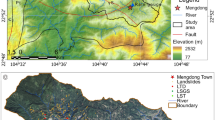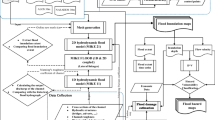Abstract
The length and steepness of the slope (LS-Factor) describe the role that topography plays in the hazard of soil erosion and constitutes one of the five factors that allow the determination of soil loss using the Revised Universal Soil Loss Equation (RUSLE) mathematical model. This factor is calculated using Digital Elevation Models (DEM); however, its spatial scale may affect the quality of its estimation. The objective of the present investigation was to analyze the sensitivity of the DEM spatial resolution in the calculation of RUSLE LS-Factor and to determine its implications in the estimation of soil erosion rates in Ecuadorian basins. The methodology considered the delimitation of the hydrographic basins and the evaluation of data from SRTM, HydroSHEDS and ALOS PALSAR as providers of DEMs databases through the implementation of two statistical methods. The delimitation of the basins was obtained from the regional literature and the DEMs databases from web servers. Comparisons of the results at the national scale and at the basin scale were established using the original spatial scales and a common scaling of 1 and 4 km. The results will make it possible to determine the most appropriate spatial scale of DEM database to determine soil erosion rates considering the particular conditions of the study area, applying the RUSLE model.







Similar content being viewed by others
Data availability
Data will be made available on request.
References
Batista PV, Davies J, Silva ML, Quinton JN (2019) On the evaluation of soil erosion models: Are we doing enough? Earth Sci Rev 197:102898. https://doi.org/10.1016/j.earscirev.2019.102898
Borrelli P, Robinson DA, Fleischer LR, Lugato E, Ballabio C, Alewell C, Panagos P (2017) An assessment of the global impact of 21st century land use change on soil erosion. Nat Commun 8(1):1–13. https://doi.org/10.1038/s41467-017-02142-7
Borrelli P, Alewell C, Alvarez P, Anache JAA, Baartman J, Ballabio C, Panagos P (2021) Soil erosion modelling: A global review and statistical analysis. Science of the total environment, 780: 146494. https://doi.org/10.1016/j.scitotenv.2021.146494
De Noni G, Asseline J, Viennot M (2000) Erosion des sols volcaniques de la cordillère des Andes, en Equateur. Revue De Géographie Alpine 88(2):13–26
Delgado D, Sadaoui M, Ludwig W, Méndez W (2022) Spatio-temporal assessment of rainfall erosivity in Ecuador based on RUSLE using satellite-based high frequency GPM-IMERG precipitation data. CATENA 219:106597. https://doi.org/10.1016/j.catena.2022.106597
Delgado D, Sadaoui M, Ludwig W, Mendez W (2023) Depth of the pedological profile as a conditioning factor of soil erodibility (RUSLE K-Factor) in Ecuadorian basins. Environ Earth Sci 82(12):286. https://doi.org/10.1007/s12665-023-10944-w
Delgado D, Sadaoui M, Pacheco H, Méndez W, Ludwig W (2021) Interrelations between soil erosion conditioning factors in basins of ecuador: contributions to the spatial model construction. In: Proceedings of the 1st international conference on water energy food and sustainability (ICoWEFS 2021). ICoWEFS 2021. Springer, Cham. https://doi.org/10.1007/978-3-030-75315-3_94
Desmet P, Govers G (1996) A GIs procedure for automatically calculating the USLE LS factor on topographically complex landscape units. J Soil Water Conserv 51:427–433
Earth Resources Observation and Science Center (EROS). (2017). Shuttle Radar Topography Mission (SRTM) 1 Arc-Second Global . U.S. Geological Survey. https://doi.org/10.5066/F7PR7TFT
Elnashar A, Zeng H, Wu B, Fenta AA, Nabil M, Duerler R (2021) Soil erosion assessment in the Blue Nile Basin driven by a novel RUSLE-GEE framework. Sci Total Environ 793:148466. https://doi.org/10.1016/j.scitotenv.2021.148466
Environmental Systems Research Institute (ESRI). (1992). ArcWorld, 1:3M, Redlands, Calif.
Environmental Systems Research Institute (ESRI). (1993). Digital chart of the world, 1:1M, Red-lands, Calif.
Harden CP (2001) Soil erosion and sustainable mountain development. Mt Res Dev 21(1):77–83. https://doi.org/10.1659/0276-4741(2001)021[0077:SEASMD]2.0.CO;2
Harden C (1988) Mesoscale estimation of soil erosion in the Rio Ambato drainage, Ecuadorian Sierra. Mountain Research and Development, 331–341. https://doi.org/10.2307/3673556
Lehner B, Verdin K, Jarvis A (2008) New global hydrography derived from spaceborne elevation data. EOS Trans Am Geophys Union 89(10):93–94. https://doi.org/10.1029/2008EO100001
Li K, Wang L, Wang Z, Hu Y, Zeng Y, Yan H, Shi Z (2022) Multiple perspective accountings of cropland soil erosion in China reveal its complex connection with socioeconomic activities. Agriculture, Ecosyst Environ 337:108083. https://doi.org/10.1016/j.agee.2022.108083
McCool DK, Brown LC, Foster GR, Mutchler CK, Meyer LD (1987) Revised slope steepness factor for the Universal Soil Loss Equation. Transactions of the ASAE 30(5):1387–1396
Melkam, E. (2003). Crop Land Soil Erosion Prediction Using WEEP Model.
Mendoza EFM, Arteaga EAG, Delgado D (2023) La erosividad de la lluvia como factor condicionante de la erosión hídrica en Manabí. Polo Del Conocimiento 8(2):68–81
Molina A, Govers G, Vanacker V, Poesen J, Zeelmaekers E, Cisneros F (2007) Runoff generation in a degraded Andean ecosystem: Interaction of vegetation cover and land use. CATENA 71(2):357–370. https://doi.org/10.1016/j.catena.2007.04.002
Molnar D, Julien P (1998) Estimation of upland erosion using GIS. Comput Geosci 24:183–192
Montanarella L, Badraoui M, Chude V, Costa IDSB, Mamo T, Yemefack M, McKenzie N (2015) Status of the world's soil resources: main report. Embrapa Solos-Livro científico (ALICE). http://www.alice.cnptia.embrapa.br/alice/handle/doc/1034770
Mukherjee S, Joshi PK, Mukherjee S, Ghosh A, Garg RD, Mukhopadhyay A (2014) Evaluation of vertical accuracy of open source Digital Elevation Model (DEM). Int J Appl Earth Observ Geoinf 21:205–217. https://doi.org/10.1016/j.jag.2012.09.004
Ochoa-Cueva P, Fries A, Montesinos P, Rodríguez-Díaz JA, Boll J (2015) Spatial estimation of soil erosion risk by land-cover change in the andes of southern ecuador. L Degrad Dev 26:565–573. https://doi.org/10.1002/ldr.2219
Pacheco HA, Méndez W, Moro A (2019) Soil erosion risk zoning in the Ecuadorian coastal region using geo-technological tools. Earth Sci Res J 23(4):293–302. https://doi.org/10.15446/esrj.v23n4.71706
Panagos P, Borrelli P, Meusburger K (2015) A new European slope length and steepness factor (LS-Factor) for modeling soil erosion by water. Geosciences 5(2):117–126. https://doi.org/10.3390/geosciences5020117
Panagos P, Ballabio C, Himics M, Scarpa S, Matthews F, Bogonos M, Borrel-li P (2021) Projections of soil loss by water erosion in Europe by 2050. Environ Sci Policy 124:380–392. https://doi.org/10.1016/j.envsci.2021.07.012
Párraga AJF, Tejena ÁAR, Gutiérrez DAD (2023) Análisis de la distribución espacial de la erodabilidad del suelo en la cuenca del Río Esmeraldas-Ecuador. Polo Del Conocimiento 8(2):82–95
Renard KG, Laflen JM, Foster GR, McCool DK (1991) The revised universal soil loss equation. In Soil erosion research methods (pp. 105–126). Routledge.
Renard KG, Foster GR, Weesies GA, McCool DK, Yoder DC (1996) Predicting soil erosion by water: A guide to conservation planning with the Revised Universal Soil Loss Equation (RUSLE). Agriculture handbook, 703.
Reyes P (2013) Évolution du relief le long des marges actives: étude de la déformation Plio-Quaternaire de la cordillère côtière d'Équateur (Doctoral dissertation, Université Nice Sophia Antipolis).
Senanayake S, Pradhan B, Alamri A, Park HJ (2022) A new application of deep neural network (LSTM) and RUSLE models in soil erosion prediction. Sci Total Environ 845:157220. https://doi.org/10.1016/j.scitotenv.2022.157220
Thomas J, Joseph S, Thrivikramji KP (2018) Assessment of soil erosion in a tropical mountain river basin of the southern Western Ghats, India using RUSLE and GIS. Geosci Front 9(3):893–906. https://doi.org/10.1016/j.gsf.2017.05.011
Vanacker V, von Blanckenburg F, Govers G, Molina A, Poesen J, Deckers J, Kubik P (2007) Restoring dense vegetation can slow mountain erosion to near natural benchmark levels. Geology 35(4):303–306. https://doi.org/10.1130/G23109A.1
Vanacker V, Molina A, Rosas MA, Bonnesoeur V, Román-Dañobeytia F, Ochoa-Tocachi BF, Buytaert W (2022) The effect of natural infrastructure on water erosion mitigation in the Andes. Soil 8(1):133–147. https://doi.org/10.5194/soil-8-133-2022
Véliz MAM, Guillen PAF, Delgado D (2023) Evaluación espacio-temporal del factor C de la Rusle entre las cuencas del río Portoviejo y Chone. Domino De Las Ciencias 9(3):1300–1315
Acknowledgements
Authors thank the FSPI—Doctoral Schools Project of the French Embassy in Ecuador, funded by the Ministry of Europe and Foreign Affairs.
Funding
The authors have not disclosed any funding.
Author information
Authors and Affiliations
Contributions
All authors worked equally in the preparation of the manuscript.
Corresponding author
Ethics declarations
Competing interests
The authors declare no competing interests.
Additional information
Publisher's Note
Springer Nature remains neutral with regard to jurisdictional claims in published maps and institutional affiliations.
Rights and permissions
Springer Nature or its licensor (e.g. a society or other partner) holds exclusive rights to this article under a publishing agreement with the author(s) or other rightsholder(s); author self-archiving of the accepted manuscript version of this article is solely governed by the terms of such publishing agreement and applicable law.
About this article
Cite this article
Delgado, D., Sadaoui, M., Ludwig, W. et al. DEM spatial resolution sensitivity in the calculation of the RUSLE LS-Factor and its implications in the estimation of soil erosion rates in Ecuadorian basins. Environ Earth Sci 83, 36 (2024). https://doi.org/10.1007/s12665-023-11318-y
Received:
Accepted:
Published:
DOI: https://doi.org/10.1007/s12665-023-11318-y




